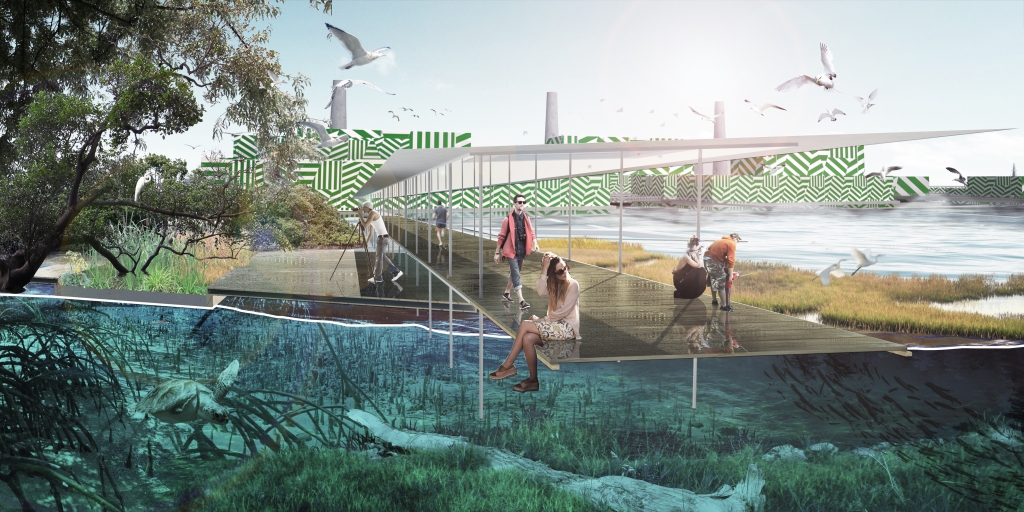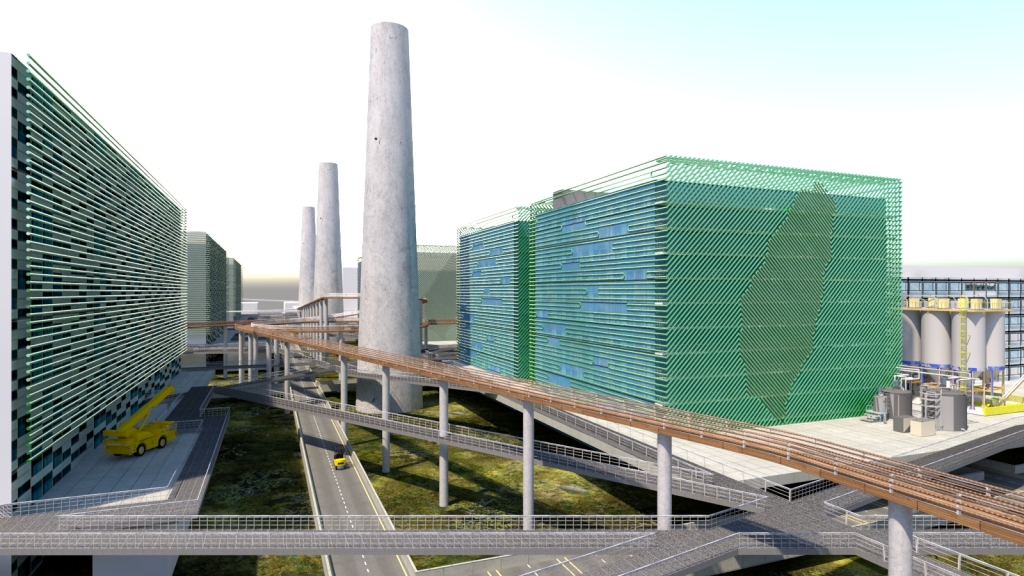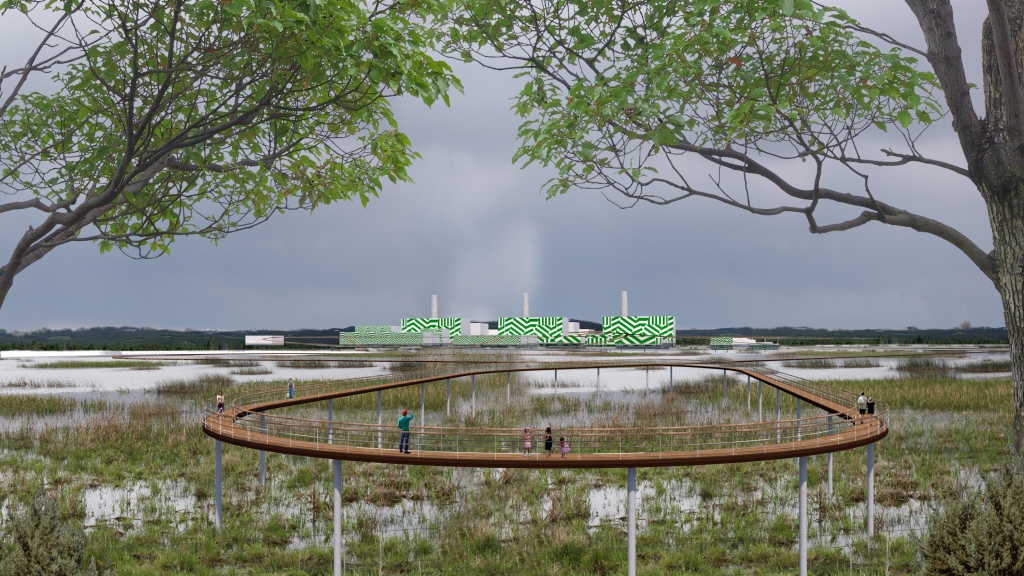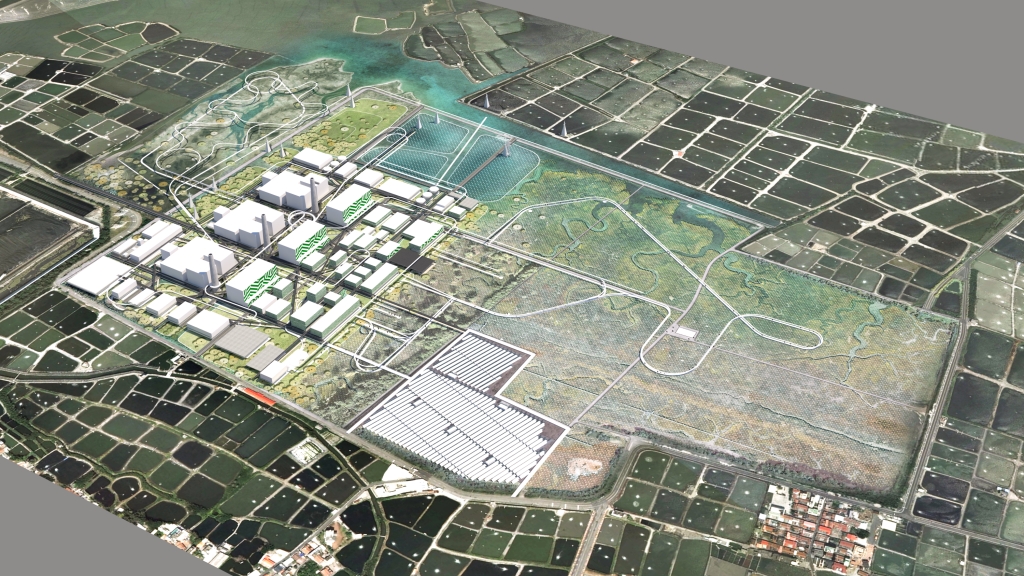Hsinta Ecological Power Plant
Hsinta Ecological Power Plant
INTRO
Together with the leading nations of the world, Taiwan is heading towards the decommissioning of its nuclear generators in favor of renewable energy sources. The Hsinta Natural Gas Units Replacement Plan aims to address power shortage resulting from the future decommissioning of nuclear energy, enhance performance and efficiency, and reduce CO2 emissions.The imminent energy shortfall in Taiwan is a matter of national urgency. However, the power plant is located at an ecologically sensitive site in southwestern Taiwan, and although its location is advantageous for the operations and logistics of a gas turbine power plant, its position next to an important wetland was not originally taken into account. Furthermore, this unique landscape ecology sits on top of historical former salt plains, having gradually grown over time.
Now that the Hsinta Plan for Plant No. 2 is in motion, Taipower and the Taiwanese government are calling for a holistic strategy for the expansion of the plant’s energy capacity, which simultaneously integrates the wetlands into the entire system without adversely affecting the balance of the natural environment here. The project aims to address these issues through a series of sensitive interventions on the site via three timeframes: mitigating and rehabilitating the existing conditions from past interventions; creating and enhancing ecological landscapes to engage present-day exigencies; and preparing for the implementation of future solutions through scientifically proven carbon sequestration technologies for the purposes of renewable energies instead of pure geological storage of supercritical CO2.
The holistic approach is unique, but sorely needed for a site of such complexity. Because of this, the design will also integrate itineraries and walking routes for visitors deep into the inner workings of the core zone, while still maintaining a separation from the plant’s day-to-day operations. This route will take them on a tour from the double-generators to maintenance, reparations, and operational infrastructure, carbon capture and sequestration facilities, and finally through the landscape ecologies to experience the symbiotic processes of biodiversity and their relationship with the power plant. This ensemble allows for the expansion of the Hsinta Power Plant, but at the same time encourages the wetlands and its natural surroundings to flourish.
TO FIX THE PAST
MITIGATE
The Eco-power plant will be built on a coastal wetland habitat, eliminating a critical stopover site for migratory birds in the East Asian–Australasian Flyway. Creation and/or restoration of wetlands offsite will be essential to mitigate lost habitat in addition to improving the local ecology.
RESTORE
Looking beyond the site, it is also important to understand the greater ecological context and consider the impacts of wetland loss in Taiwan and globally over the past century. In addition to supporting wildlife, a progressive approach to restoring wetlands will support essential ecosystem services including improved water quality, reduced flood risk, and nursery grounds for marine fisheries.
TO ENGAGE THE PRESENT
CREATE
The landscape around the Eco-power plant will create new habitats that can provide opportunities for people and wildlife. Flood retention areas will support a new freshwater habitat, with treatment wetlands improving the quality of site runoff. Outside of the core area, modified levees allow tidal flows to re-enter the existing wetland and salt pond areas, passively restoring critical the coastal marsh and mangrove habitat.
ENHANCE
The Eco-power plant has an opportunity to enhance biodiversity across the site. Representing a gradient of coastal habitats, the mosaic of new and restored habitats will offer a greater variety of food sources for resident and migratory birds that provides greater ecological resilience and adaptability in the face of climate change and rising sea-levels.
TO PREPARE FOR THE FUTURE
STORAGE
The story of Carbon Capture and Storage (CSS) is at the foundation of the Eco-power plant landscape experience, exploring passive and active strategies. With significantly higher sequestration rates of any ecosystem the restored mangroves and coastal salt marshes frame the site, presenting opportunities for research and education. Deep below the landscape, injection wells test new methods of carbon storage.
RE-USE/GENERATE
Exploring CO2 as a resource, the sun-drenched roof and facades of the Eco-power plant are laced with algae tubes, sequestering the carbon into a useable by-product. This experimental algae farm offers an additional research and educational experience, where algae can then be extracted to make biofuel (a clean energy countering the effects of the fossil fuel power plant) and the remaining biomass can be used as fertilizer at local farms.
CORE ZONE STRATEGY
In order to integrate the trinity of wetlands, flood retention areas, and carbon capture zones with the entire site itself, the core zone is designed and adapted to allow for their natural incursion into its interstitial spaces. This is achieved by elevating all building elements from the ground and allowing all ecological pathways to occur uninterrupted from the carbon storage zone in the north, through the power generation zone and towards the wetland zone in the south. This unique intervention also becomes an attractive tourist and education destination. Tourists are channeled through elevated walkways so as not to interrupt the operations of the vehicles, workmen, and utility pipes, each of which have their respective infrastructures.
The site is currently home to hundreds of species of migratory birds, and their related food sources and biodiversity. The strategies will increase the viability of these species as well as resilience against inclement weather and long-term effects of climate change by simply minimizing physical proximity to the sensitive habitats. With carefully selected plant and sedimentation strategies within the buffer zone, industrial water discharge will be naturally treated to ensure a balanced ecosystem in this area before being released to the sea via a flood retention zone.
In order to minimize the visual impact of the core zone structures, we have devised a façade system that camouflages the immensity of the buildings from the wetlands’ vantage point. The design is inspired by ‘dazzle’ camouflage paint on Allied navy ships during the Second World War. During a time when radar capability was considered an early and primitive technology, ship commanders adopted these paint designs to obscure the true geometry of the ship when seen from a distance. We have updated this design to use algae tubes instead to maximize their performance not only as devices for shading and power generation, but also for visual impact attenuation.
-
Client
Taiwan Power Company
-
Location:
Kaohsiung, Taiwan
-
Year:
2017
-
Size:
78-hectare land for power plant construction, 41.25-hectare Yongan Wetland, 9.45 hectares PV area, 1.3-hectare heritage site
-
Collaborator:
Sasaki Associates
-
Status:
Competition, Selected Award
Share project





